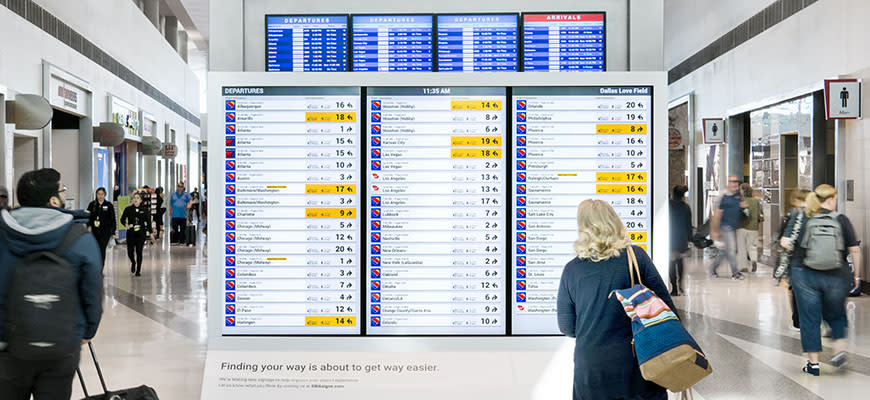
Sometimes, in innovation and design, identifying the right pain points is a challenge. This is not the case with air travel. The problem’s clear to anyone who has ever been aloft: the airport. The airlines themselves understand the woeful shortcomings of most airports and are motivated, and currently prosperous enough, to do something about it.
“I think the next area of competition in air travel is in the airport,” said Paul Jacobson, executive vice president and CFO of Delta said, at recent CNBC conference. “How do you continue to streamline the on-the-ground experience. It is a big part of how passengers rate the experience.”
The big question: Where should airline leaders invest their innovation dollars?
“I think the next area of competition in air travel is in the airport. How do you continue to streamline the on-the-ground experience. It is a big part of how passengers rate the experience.”
“Airports invest $10BN a year to modernize their infrastructure,” writes our Toby Bottorf in Design Observer. “Imagine the returns on investment if a small percentage of that were dedicated to defining and designing the right experience for workers and travelers, not just on the build-out of spaces and systems.”
At EPAM Continuum, we understand how great design can make an impact on the airport experience. We recently did a project with Southwest Airlines, in which we helped radically redesign their in-airport experience with digital wayfinding. It was a true success: “96% of customers said the new signs made it easier to navigate the airport, and customers rated the usefulness of the new system as 4.77 on a 5-point scale. Additionally, Southwest's positive reputation gave the signs added credibility with many customers.”
With Wall Street now considering the airport experience, and the brand differentiation it can provide in the metrics used to evaluate an airline's value, it’s an ideal time for air carriers to impove the airport experience. Here are some options for innovation investment.
Beyond the Terminal
The airport experience extends beyond the doors of the terminal. Airlines need to consider the entire journey of the passenger to uncover opportunities for improving the experience. At EPAM Continuum, we do research by doing "ride-alongs"—a practice we employed in our future of first response project—to understand the entire context of a user’s journey. It would certainly benefit airlines to tag along with their customers, on the door-to-door journey. After all, negative interactions passengers experience, before reaching the terminal and after they leave, could have domino effects that need to be considered even if they’re out of the control of the airlines.
Building End-to-End Experiences
When airlines understand the context of their passenger’s lives, and the underlying emotional and functional drivers, they can create experiences that are fluid and adapt to meet the needs of customers as they change and evolve. When passengers gained the ability to check-in from the comfort of their couches it changed the way we interact upon first arrival to the airport. Airlines need to continue exploring ways they can reduce the friction of travel both before and after passengers are in their terminals.
Different Modalities of Travel
Airlines need to continue exploring ways they can reduce the friction of travel both before and after passengers are in their terminals.
Air carriers need to understand the different functional and emotional needs of passengers. Business travelers have different motivations and needs than, say, a family of four departing for a vacation. It’s time they spent time truly understanding the different modalities of travel, what the various segments require and how the airport experience can evolve to meet these needs.
Designing for the Different Travelers
When companies engage in deep ethnographic learning, they can uncover some unexpected needs and pain points of their customers. These opportunities can be easily missed when we gather feedback using surveys and focus groups. Airlines must get to know their people better.
Considering Both Sides of the Experience
Smart airlines recognize the need to pay attention to the employee experience as well. So much of airlines’ focus is on the passenger experience, and often they forget about the people on the front line delivering these services. It's paramount to give these employees the frameworks and tools to deliver experiences and build in moments of delight.
Empowered Employees Enable Delightful Experiences
Airlines can build the best possible experience for its passengers but if they don’t think about the implications behind the scenes, it’s highly unlikely that any of them will be successful. The employees need to be empowered to deliver the best possible experience and given the flexibility to adapt when they hit turbulence. Happy employees make for happy passengers.
To Create or to Redesign? That Is the Question.
The United States has invested a lot of money in building airports in the middle of the 20th century, but other countries are now catching up economically and they're spending big dollars on shiny show-ready airports. Singapore, for instance, and Shanghai. These foreign airports are looking at designing for the experience, as opposed to US airports, where it's all about getting in and out as quickly as possible. Are there opportunities for American airports that airlines have yet to explore?
Thinking Smarter About Current Footprints
Airlines and airports are exploring alternatives that exist outside the walls of the traditional terminal because it allows them to be unconstrained by the spatial limitations of today’s aging infrastructure. Others are creating entirely new satellite hubs that consider the demands of fighting traffic to travel into a city just to jump on plane and leave it. These hubs remain limited in their offerings and will cater to a small subsection of travel. The traditional airport isn’t going anywhere for the foreseeable future, and we’d be remiss if we didn’t think about how we can redesign a space that’s multi-modal and can utilize the limited space effectively. We’ve all walked by an entirely empty section in an airport only to be met with overcrowded gate area with frustrated travelers jockeying for space. Airlines need to be smarter with the space they have before building millions of additional square feet that will need continuous maintenance, upgrades, and eventual renovations.
It’s vital to involve travelers and airline employees, the true innovation co-pilots, in the development of new experiences.
The Human-Centered Digital Upgrade
One thing our Southwest project taught us was that digital design can be used to reconceive the airport in effective ways. We're seeing airlines invest significantly in efforts like wayfinding and check-in. It is possible to utilize digital tools to streamline decades-old processes—but doing so only makes sense if it’s done in a way that feels appropriate to the people who will use it. For an airline, investing in digital is futile if your employees and customers aren’t ready for transformation.
Navigating the Future
It’s important to have a clear vision for their ideal passenger experience. Without this target in mind, it will be difficult for airlines to undertake complex challenges that often need to span across silos within an organization. At EPAM Continuum we use a process of backcasting. We create an ideal vision that is three-to-five (sometimes more) years away and create a roadmap with the necessary steps needed to achieve this vision. Oftentimes there are technological and organizational hurdles that will need to be solved before the ideal experience can be achieved. That is why it’s so important have a clear vision that enables true innovation.
Whichever options an airline chooses to pursue, it’s important that they develop their experiences in responsible ways—by prototyping their ideas, and testing them in appropriate contexts, before building them out. It’s vital to involve travelers and airline employees, their true innovation co-pilots, in the development of new experiences. Without including them, the new-and-improved airport experience is unlikely to fly.




